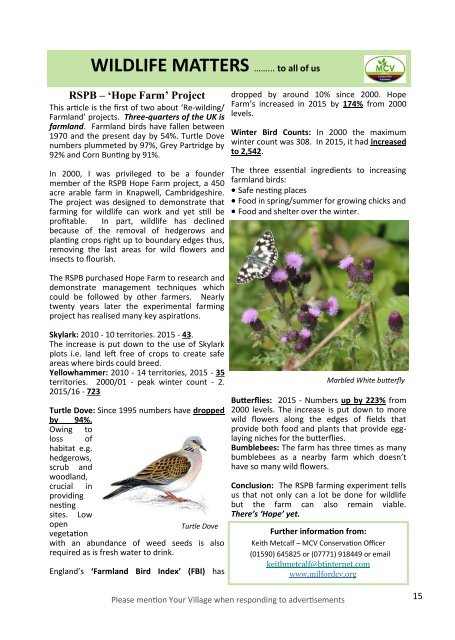Your Village Hordle April May 19
Community Magazine
Community Magazine
- No tags were found...
Create successful ePaper yourself
Turn your PDF publications into a flip-book with our unique Google optimized e-Paper software.
WILDLIFE MATTERS ……... to all of us<br />
RSPB – ‘Hope Farm’ Project<br />
This article is the first of two about ‘Re-wilding/<br />
Farmland’ projects. Three-quarters of the UK is<br />
farmland. Farmland birds have fallen between<br />
<strong>19</strong>70 and the present day by 54%. Turtle Dove<br />
numbers plummeted by 97%, Grey Partridge by<br />
92% and Corn Bunting by 91%.<br />
In 2000, I was privileged to be a founder<br />
member of the RSPB Hope Farm project, a 450<br />
acre arable farm in Knapwell, Cambridgeshire.<br />
The project was designed to demonstrate that<br />
farming for wildlife can work and yet still be<br />
profitable. In part, wildlife has declined<br />
because of the removal of hedgerows and<br />
planting crops right up to boundary edges thus,<br />
removing the last areas for wild flowers and<br />
insects to flourish.<br />
The RSPB purchased Hope Farm to research and<br />
demonstrate management techniques which<br />
could be followed by other farmers. Nearly<br />
twenty years later the experimental farming<br />
project has realised many key aspirations.<br />
Skylark: 2010 - 10 territories. 2015 - 43.<br />
The increase is put down to the use of Skylark<br />
plots i.e. land left free of crops to create safe<br />
areas where birds could breed.<br />
Yellowhammer: 2010 - 14 territories, 2015 - 35<br />
territories. 2000/01 - peak winter count - 2.<br />
2015/16 - 723<br />
Turtle Dove: Since <strong>19</strong>95 numbers have dropped<br />
by 94%.<br />
Owing to<br />
loss of<br />
habitat e.g.<br />
hedgerows,<br />
scrub and<br />
woodland,<br />
crucial in<br />
providing<br />
nesting<br />
sites. Low<br />
open<br />
Turtle Dove<br />
vegetation<br />
with an abundance of weed seeds is also<br />
required as is fresh water to drink.<br />
England’s ‘Farmland Bird Index’ (FBI) has<br />
dropped by around 10% since 2000. Hope<br />
Farm’s increased in 2015 by 174% from 2000<br />
levels.<br />
Winter Bird Counts: In 2000 the maximum<br />
winter count was 308. In 2015, it had increased<br />
to 2,542.<br />
The three essential ingredients to increasing<br />
farmland birds:<br />
• Safe nesting places<br />
• Food in spring/summer for growing chicks and<br />
• Food and shelter over the winter.<br />
Marbled White butterfly<br />
Butterflies: 2015 - Numbers up by 223% from<br />
2000 levels. The increase is put down to more<br />
wild flowers along the edges of fields that<br />
provide both food and plants that provide egglaying<br />
niches for the butterflies.<br />
Bumblebees: The farm has three times as many<br />
bumblebees as a nearby farm which doesn’t<br />
have so many wild flowers.<br />
Conclusion: The RSPB farming experiment tells<br />
us that not only can a lot be done for wildlife<br />
but the farm can also remain viable.<br />
There’s ‘Hope’ yet.<br />
Further information from:<br />
Keith Metcalf – MCV Conservation Officer<br />
(01590) 645825 or (07771) 918449 or email<br />
keithmetcalf@btinternet.com<br />
www.milfordcv.org<br />
Please mention <strong>Your</strong> <strong>Village</strong> when responding to advertisements<br />
15


















